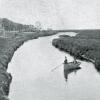The long history of the Cannonball House
The historic Cannonball House in Lewes has been in the news recently after it was discovered a replica cannonball welded into the foundation of the building was missing. In the days following, there was confusion among the general public whether the cannonball was the original munition that lodged into the building during the British bombardment April 7-8, 1813.
This undated photograph from the Delaware Public Archives should put to rest any question. It shows a patched area in the foundation where the building was struck, but no cannonball is present.
Although it’s now owned by the Lewes Historical Society and serves as its Maritime Museum, the building had many uses over the last 200-plus years. According to Volume VI of the Journal of the Lewes Historical Society, the land where the home stands at the corner of Front and Bank streets has been owned by many families, including the Neils, Allens, Beebes and McCrackens.
Deed records show the McCrackens owned the home during the British bombardment. Later, around the turn of the 20th century, it was a sundry goods store owned by Susan Rowland. In the 1930s, it was the mayor’s house; in the 1940s, it was the Lewes Service Centre, a business run by William “Skip” Carpenter. From 1946-52, it was home to Joe’s Taxi Stand. It was then purchased by the Papajohns of Rehoboth Beach. During this time, a pair of restaurants operated in the house.
The historical society purchased the soon-to-be-named Cannonball House in 1963 for $28,000. At the time of the purchase, the home was known as David Rowland House after a previous owner who was a pilot for the Bay and River Delaware.




















































